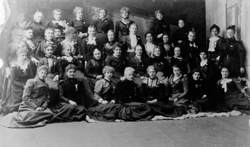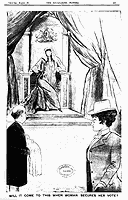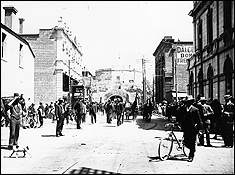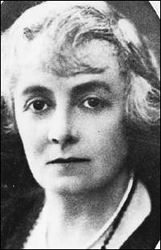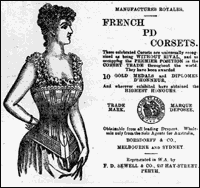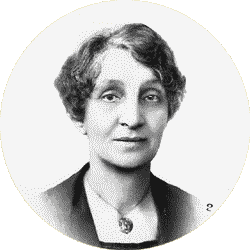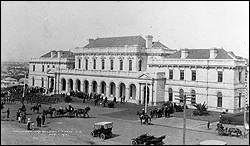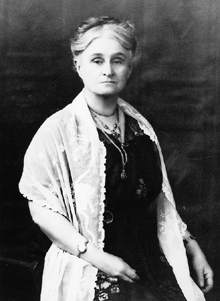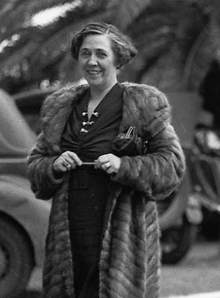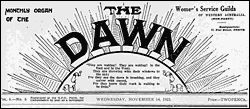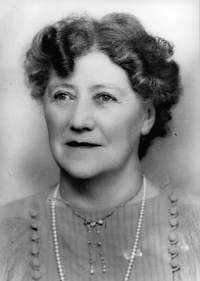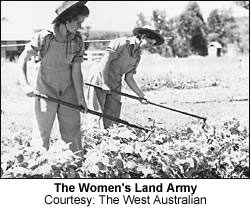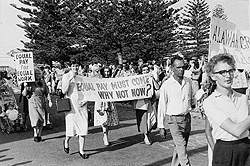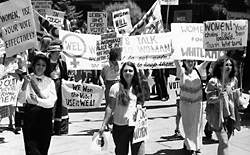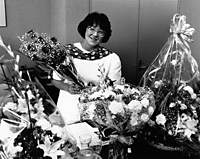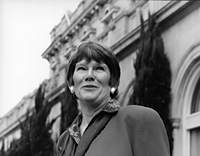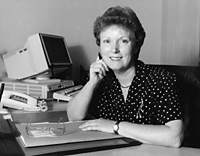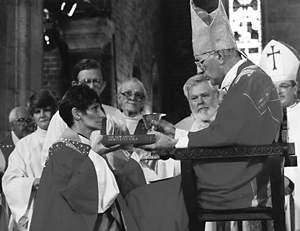Western Australia was among the world leaders in recognising that women should have the vote. This exhibition is supported by extensive Teachers Notes for both Primary and Secondary students.
1890
Show more
A century ago, when Perth was the most far-flung outpost of the British Empire, the population of Western Australia was dominated (almost two-to-one) by men.
The woman's place was in the kitchen, where she could keep the home fires burning, raise the children and fulfil her wedding vow to `honour and obey' her husband. If she was unfortunate enough to be single, her position was even more difficult as there was no clear life role for her and employment opportunities were very limited.
Women's opinions were rarely sought on political issues, and their voices seldom heard outside the accepted avenues of social conversation. It was very much a man's world. Men made the laws - and their laws favoured men. Some women were content with a system which regarded them as their husband's property. Fortunately for women today, many more were not.
Pioneers like Emily Hensman, Margaret Forrest, Madeleine Onslow, Gwenyfred James, Edith Cowan and Roberta Jull became leaders of a women's movement devoted to advancing the rights and status of colonial women - married and single. They discovered their own political voice... and they wanted to be heard.
In 1892 six branches of the Woman's Christian Temperance Union (WCTU) were formed in Western Australia. Concerned about the role of women and the family in a very much male-dominated society, the WCTU recognised the importance of female suffrage in the pursuit of badly needed social reforms. The WCTU held public meetings and circulated a petition that was later pasted onto a mile-long length of cloth.
The Woman's Christian Temperance Union
Perth Convention Group
Courtesy of the Woman's Christian Temperance Union
"Will it come to this when woman secures her vote?"
The Coolgardie Pioneer,
20 August, 1898
Courtesy of the Battye Library
Walter James, the Member for East Perth, made several attempts to persuade Parliament to give women the vote. But the idea was not well received. The Premier, Sir John Forrest, was not convinced that women were really interested in voting. Women's opinions were rarely sought on political issues, and their voices seldom heard outside the accepted avenues of social conversation.
One of the other members went so far as to say that `ladies, like cats, were best at home'.
Opposition was not confined to political conservatives. There was also concern that women's suffrage would greatly increase the voting power of Perth and established country centres relative to that of the more radical Goldfields, where there were very few women. But the resolve of WA's pioneering women was undeterred. From 1896 the WCTU campaigned for the vote with increasing vigour, writing to newspapers and holding public meetings in Perth, Bunbury, Northam and York.
In July 1898 The West Australian came out in favour of women's suffrage.
Then in 1899 the WCTU joined with other women's groups, including the Karrakatta Club, to form the Woman's Franchise League. Another petition was circulated and presented to Parliament on 26 July 1899. The pressure mounted.
At last, in August 1899, both Houses of Parliament passed a motion in favour of women's suffrage.
The Constitution Acts Amendment Act was passed on 16 December 1899 and proclaimed on 18 May 1900, giving women the same voting rights as men. This didn't mean that all women over the voting age of 21 were entitled to vote: Aboriginal Australians, Africans and Asians (male and female) were all excluded unless they were substantial landowners.
Western Australian women were among the first in the world to secure the right to vote. Only New Zealand, South Australia and a few States in America had taken this bold step sooner
High Street Fremantle
Courtesy of the Battye Library
Western Mail, 19 May, 1899
Courtesy of The West Australian
1900
Show moreWomen in the other colonies (apart from South Australia) did not have the opportunity to vote on this issue because they had not yet gained the franchise.
It wasn't until 1902 that women in New South Wales won the right to vote. Also in that year, women throughout Australia were given the right to vote in Commonwealth elections on the same terms as men. Tasmania followed in 1903, and Queensland in 1905. Finally, in 1908, Victoria stepped into line with the rest of the nation. Women now had an equal vote with men, but not equality in other areas.
In 1907 the concept of the basic wage was introduced in Australia, with the rate for a woman set at 54% of that for a man. Inequalities such as this moved Edith Cowan, Bessie Rischbieth and Frances Ruffy Hill to set up the Women's Service Guild in 1909, with the aim of educating women on social, political and economic questions and working toward the establishment of equal rights for men and women.
Meanwhile, Aboriginal women were `protected' by laws that controlled many aspects of their lives - allowing marriage to a white man only by permission, employment only by permit, and denying them custody of their own part-white children.
Bessie Rischbieth
Courtesy of The West Australian
1910
Show moreDivorce laws were made more equitable, King Edward Memorial Hospital was established as a women's hospital, women justices were appointed to the Children's Court, and barmaids and female musicians were granted equal pay with men.
The controversial Conscription Referendum in 1916 included much campaigning aimed directly at mothers and wives. And a maternity allowance of five pounds was made payable to new mothers in 1912, although Aboriginal mothers were not eligible.
The decade closed with a major step forward: 21 years after winning the right to vote Western Australian women were now eligible to stand for State Parliament on the same terms as men.
Frances Ruffy Hill
Courtesy of The West Australian
Parliament House Perth 1918
Courtesy of The Battye Library
1920
Show moreEdith Cowan was in her sixties when she entered parliament, after many years of social activism. Her aim was to make an impact in a number of areas of vital importance to women, such as divorce court reform, guardianship of children, and the reform of inheritance law. She was also determined to open up the legal profession to women.
The initial press response was demeaning. Cartoons in The Bulletin portrayed Edith Cowan interrupting the important affairs of parliament with a woman's `housewifely instincts'.
Despite the attempted stereotyping, Edith Cowan was a forceful parliamentarian. She introduced and saw enacted the Women's Legal Status Act, which enabled women to practice law. It was a major milestone in the achievement of women's rights. Although she failed to win her seat of West Perth in the next election she had opened the door to the political arena for women.
The next woman to step through the door was May Holman, first elected in 1925 and the first female Labour parliamentarian in the world. She was to occupy the seat of Forrest for the next fourteen years, at a time when Western Australia was at the forefront of the Australian women's movement.
Edith Cowan
Courtesy of The West Australian
May Holman
Courtesy of The West Australian
1930
Show moreIn 1934 Florence Cardell-Oliver polled 18,000 votes and almost won the Federal seat of Fremantle. She was more successful in 1936, winning the State seat of Subiaco, which she was to hold for 20 years.
Florence Cardell-Oliver was a tireless worker for the needy and was especially concerned about the health of children from low income families. She declared she would `take the bull by the horns and get free milk for the children'. Her efforts created the school milk scheme, which ensured that generations of children received a daily quota of free milk.
By the time Florence Cardell-Oliver entered Parliament, May Holman had become the first woman in the British Empire to hold a seat for ten years. She remained an active Member of Parliament until her accidental death in 1939.
Magazine masthead
Courtesy of The Women's Service Guild
Florence Cardell-Oliver
Courtesy of The West Australian
1940
Show moreMany women discovered for the first time what it was like to work outside the domestic environment, to be responsible for more than their husband's happy home. It was a taste of a wider life they would not easily surrender; by the time the boys returned many women were jealous of the jobs they had to give up.
A new slogan was heard in the women's movement - 'Equal Pay for Equal Work'!
The Women's Land Army was formed to 'fight the silent Battye, on the front behind the front'.
In 1943, a Western Australian woman created Australian political history once again. Dorothy Tangney became the first woman Senator in Australia, retaining her seat for a record 25 years.
In 1947, Florence Cardell-Oliver became the first female Cabinet Minister in Australia.
The Women's Land Army Courtesy The West Australian
1950
Show moreIn 1951 the basic wage for women was increased from 54% to 65% of the male basic wage. Although the financial gain was welcome it meant women were still being paid much less than men for the same work.
Women's organisations actively campaigned for equal pay, establishing a national committee and formulating an Australia-wide campaign strategy.
The Women's Christian Temperance Union, which had been instrumental in winning the vote half a century earlier, lent its support to the cause. Senator Dorothy Tangney was WA's representative at the 1958 National Conference on Equal Pay in Sydney.
The decade closed with the establishment of the Combined Equal Pay Committee of Western Australia. The post-war period proved women were in the workforce to stay, and one of the biggest issues of the 1950s was the fight for equal pay.
Courtesy of The Australian Labour Party - Constitutional Centre of Western Australia
1960
Show moreBy 1967 the campaign for equal pay had proved effective. Premier David Brand's State Cabinet authorised the payment of male wage and salary rates to female Government employees who were doing work of equal value.
There were also significant changes in the rights of Aboriginal Australians, male and female. In 1962 all Western Australian Aboriginal people gained the right to vote in both State and Commonwealth elections. At this stage, enrolment to vote was voluntary for Aboriginal people. (It was not until the 1980s that enrolment and voting in both State and Commonwealth elections were made compulsory for all eligible Aboriginal people, putting them on the same footing as other Australians.)
In 1967 more than 90% of Australian electors voted in favour of a referendum proposal to give the Commonwealth Parliament power to make special laws for Aboriginal people.
Courtesy of The West Australian
1970
Show moreA new branch of the long running Women's Service Guilds, called the Harvest Guild, was formed in 1972. The President, Wendy Fatin, appeared in a controversial television interview to advocate legislation for the advertising of contraceptives. She went on to become the Federal Member for Canning, then Brand, and was appointed Minister Assisting the Prime Minister for the Status of Women.
Another organisation formed in the early 70s was the Women's Electoral Lobby. One of the original members was Dot Goodrick, who later became the Lobby's representative to the Fraser Government. The Lobby aimed to give women more power, challenge the male monopoly on public decision making, obtain private and public equality for women, educate political candidates on women's issues, and obtain workplace reforms such as maternity leave and child care.
On the world stage, 1975 was designated International Women's Year and the start of the United Nation's Decade for Women. The decade ended with Margaret Thatcher being elected the British Prime Minister.
Courtesy of The West Australian
1980
Show moreIn Western Australia, the Women's Advisory Council to the Premier was established.
In 1984 the Commonwealth Sex Discrimination Act banned discrimination on the basis of sex, marital status or pregnancy, and the Equal Opportunities Act promoted the equality of women in Western Australia.
With 1987 came the beginning of `affirmative action' or `equal employment opportunity' (usually referred to simply as EEO) through the implementation of the Equal Opportunities Act.
Coinciding with Australia's Bicentennial Year, the Federal Government released its National Agenda for Women in 1988 under the title `A Say, A Choice, A Fair Go'.
1990
Show moreCarmen Lawrence became Australia's first female Premier, and her government was the first in Australia to have five female cabinet ministers simultaneously.
In the 1993 Court government Cheryl Edwardes was appointed Western Australia's first female Attorney General.
For several years Western Australian Senators representing The Greens; Christobel Chamarette and Dee Margetts, together with then Democrat Leader Cheryl Kernot, held the balance of power in the Senate.
In 1998 the controversial Davenport Bill was passed, moving regulation of abortion into the Health Act. This landmark decision meant Western Australian women would no longer face prosecution for undergoing an abortion.
As Western Australian women enter their second century of political entitlement, it is worth recalling the attitude of one of our most notable female politicians.
In 1894 Edith Cowan suggested that her women's political group, the Karrakatta Club, adopt the motto Spectemur Agendo (`Let us be judged by our actions').
Close to 30 years later her commitment to action was rewarded with a seat in State Parliament. It was the beginning of women's active participation in our formal political process, a fact she drew to the attention of her male counterparts in her first speech as a member.
"If men and women can work for the State side by side and represent all the different sections of the community...I cannot doubt that we should do very much better work in the community than was ever done before. "
That statement is as true now as it was then.
Carmen Lawrence
Courtesy of The West Australian
Cheryl Davenport
Courtesy of The West Australian
Cheryl Edwardes
Courtesy of The West Australian
The ordination of Anglican women priests
Courtesy of The West Australian



